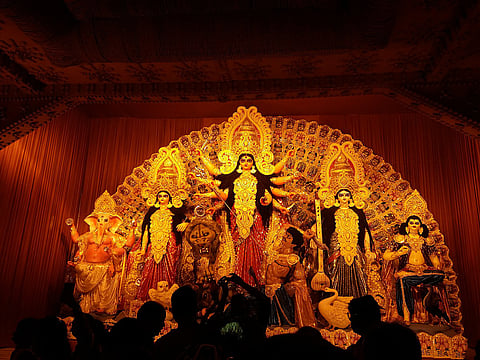
- Destinations
- Experiences
- Stay
- What's new
- Celebrating People
- Responsible Tourism
- CampaignsCampaigns
- SubscribeSubscribe
- Buy Now

Mumbai is Maximum City, Bengaluru is the Garden City, and Kolkata? Well, it is the City of Joy. Visit Kolkata during Durga Puja and you will understand why it got that label. The autumnal festival of Durga Puja is one of the most popular celebrations in Kolkata. Durga Puja was added to UNESCO's list of 'Intangible Cultural Heritage of Humanity' in 2021. UNESCO listed Durga Puja in Kolkata on its Representative List of the Intangible Cultural Heritage of Humanity, recognising the festival's special character. Durga Puja in Kolkata takes months to organise and prep, with thousands of craftspersons creating the idols and jaw-dropping structures that house them. You can read more about the art processes behind the festival in our feature here.
Kolkata resembles an open-air art gallery during Durga Puja with pandals that house the idols of the goddess looking like installations by artists. The pandals, housing the stunning Durga idols made by artisans in the ancient potters' colony of Kumartuli, are generally constructed out of bamboo, canvas, and coloured cloth. Skilled craftspersons build these over months and they resemble structures from across India and the world. Sometimes pandals also reflect a social issue. The pandals you should not miss are: Bagbazar, one of the oldest Durga Puja pandals in Kolkata. College Square pandal, located on College Street and on the bank of a waterbody. The Hindustan Park pandal, known for innovative themes and decorations. The Ballygunge Cultural Association pandal hosts a traditional style Durga Puja. Ekdalia Evergreen is one of Kolkata’s much-hyped big-budget community pandals.
Here's a piece of advice: Avoid the evening crowds and do your pandal explorations in the morning. The crowds start to build around 4pm, and by late evening, it gets almost impossible to navigate the streets and pandals.
Food is one of the many tiny details that contribute to the character of Kolkata's Durga Puja. Bengalis love to eat, and feasting with family and friends is a very important part of the celebrations. After a night of pandal-hopping, you may find people digging into an early morning breakfast of deep-fried golden radhaballabhi discs with cholar dal (a lentil preparation) and some Bengali mishti (sweets) like malai chom-chom and pantua. There are countless streetside food stalls that sell this, as do Bengali mishti shops. For lunch, people in Kolkata like to queue up for pujo bhog. An offering made to the goddess (much like a prasad), bhog is made up of a special khichuri that is made with a rice variety called Gobindobhog, and mung dal. It is served with a side of assorted fritters like begun bhaja (brinjal fry) and alu bhaja (potato fries), and a side dish called labda (a mish-mash of vegetables). While the khichuri-labra combo remains the same, sometimes a bhog can also comprise luchi (fried disks of flour) and alur-dom, or even mishti pulao (sweet rice dish) with kosha mangsho (mutton dish). You can also walk around, sampling the enormous variety of street food on offer during Durga Puja. Food kiosks spring up all over the city offering everything, from the popular Kolkata snack of jhaal-muri (spiced puffed rice) to phuchka, egg and chicken rolls, chowmein and chili chicken, momos, chaats, biryani, and more.
The Bonedi Baari pujos in Kolkata are a must-see. These are held in the stately palaces of Kolkata's aristocratic families. Most have their own "thakur dalan," or public courtyard, with pillars and verandahs that reflect European architectural influences. The Sovabajar royal family, probably the most famous Bonedi Durga Puja of Kolkata, celebrates not one, but two pujos. For a comprehensive list of Bonedi Bari pujos in and around Kolkata, check out our features here and here.
Ashtami is the day of the pushpanjali (floral offering made to the goddess with chanted mantras). Though the anjali takes place on all three days of Saptami, Ashtami, and Navami, it is the one on Ashtami that is really special. In the evening, you can check out the special puja lighting. One of the biggest draws of Durga Puja in Kolkata is the illuminations. Colourful lights and elaborate lighting turn the City of Joy into a fairytale town at night. During the day, you can also join a group tour to see the major pujas, which includes both the aristocratic homes and the neighbourhood celebrations. The West Bengal Tourism Development Corporation usually runs several packages that cover visits to important puja pandals, boat cruises, and bus trips to destinations around Kolkata. You can also join a city walk tour and explore Kolkata.
The dhunuchi dance is one of the important rituals of Durga Puja. Dhunuchi refers to an earthen pot filled with slow-burning coconut husk and fragrant incense, also known as dhuno. One of the various rituals performed during Durga Puja is the burning of incense in these pots, accompanied by the dhunuchi dance to the beats of a dhaak (traditional drums). Goddess Durga and her offspring are regarded as a part of one's own family in Bengali tradition. The dhunuchi naach is a sign of respect and sharing one's joy with the deity. Later, you can head out to the Hooghly riverside. Dotted with several ghats and jetties, it is perfect for an exploratory walk along the banks, taking in the sunset. Do check out the beautiful Palladian porch of Prinsep Ghat, built in 1883 in honour of scholar and antiquary James Prinsep.
On the final day of the festival, the Durga idols are taken out in a procession for "bisorjon" (immersion) in the river. People queue up along the routes taken by these processions to bid goodbye to the goddess. The idols are placed on a boat and taken to the middle of the Hooghly river for immersion. West Bengal Tourism, and many private tour operators, arrange for boat cruises to observe the immersion ceremony.
